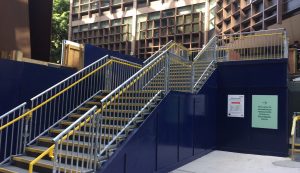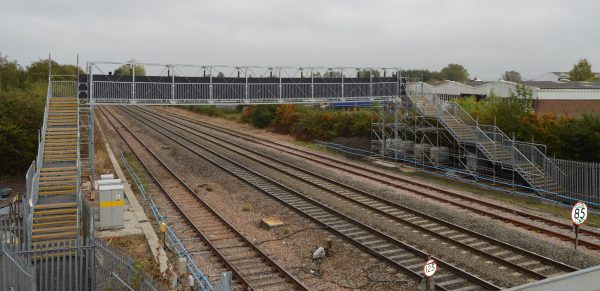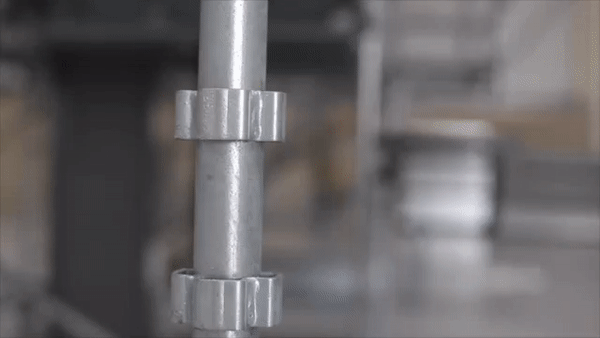Doing temporary public access, the safe way

A new wave of infrastructure projects is here. Governments around the globe are heavily investing in upgrading our rail, road and other transportation systems to accommodate increasing levels of traffic, reinvent global supply chains, and protect against natural catastrophes.
In the UK, for example, there are several large-scale transport infrastructure projects ongoing, including the HS2, Crossrail, Great North Rail Project, and A14 Improvement Scheme. In fact, if you’re travelling on a regular basis, it’s hard not to come into proximity with an upgrade, maintenance, or development project.
However, while we await the completion of these types of schemes, day-to-day life needs continue with minimal disruption; putting pressures on contractors to decrease possession time and supply safe temporary access for the public so commutes can go on.
There are many factors to consider here when it comes to doing the right thing, especially to ensure that temporary public access is safe and surrounding sites are risk-free for anyone nearby.
Footfall and slips, trips and falls
Temporary staircases for public use, for instance, must be designed and engineered to consult the relevant building and fire prevention regulations. They must also be fit for purpose, to withstand high volumes of footfall at any one time.
Some scaffolding and access suppliers have designed specialist staircases for public use, to ensure practicality and safety in situations that the standard stair towers cannot.
HAKI’s Public Access Stair (PAS), for example, offers stair widths of 2500mm and a strong loading capacity of 7.5kN/m², making it ideal for projects where high-level usage is likely. Non-slip solid decks and child-safe handrails have also been manufactured for use with the PAS, to minimize risk of slips, trips and falls – putting the safety of the public at the heart of the solution.
In addition to public staircases, some project sectors like infrastructure, often require safe, temporary footbridges to allow crossing over railways, roads and rivers whilst new or existing permanent ones are installed or upgraded. Just like the stairs, these need to protect pedestrians from falls, slips and trips.

The innovative HAKI Bridge System (HBS) has been designed specifically to do this – matching the HAKI PAS’s 7.5kN/m² loading, spacious walkways, and slip-resistant decking. Cladding can be added to enclose the HBS and PAS to improve public safety. The HBS can also be quickly erected three ways, including offsite and using a unique roll-out method, to significantly reduce possession time on rail and road projects. A win-win for contractors.
Noise pollution and risk of falling materials
Other than the obvious precaution of slips, trips and falls: noise pollution and the risk of falling materials should also be considered for temporary access projects – especially those in public areas or providing public access.
Scaffolding, in general, is renowned for creating high levels of noise – from moving and storing components, through to cutting, drilling and hammering the scaffolding – and it has been linked to hearing loss and deafness in tradesmen, as well as receiving complaints from the public.
The type of scaffolding used in temporary works can, however, help to minimize noise pollution. Some systems, like HAKI, require a lot less components and hammering to erect structures. Components are all prefabricated and simply ‘hook-on’ to each other using a spring locking-catch. This system reduces noise levels and danger of component displacement, so safety on public access structures is enhanced further.

Using fewer prefabricated components in temporary structures also lessens the risk of falling materials, in comparison to traditional tube and fitting. The HSE considers being struck by moving and falling objects as the third largest category for reported injuries, so anything that can be done by contractors to help prevent this is a step in the right direction when it comes to protecting workers and pedestrians.
Enclosing temporary public access staircases and bridges with cladding can also stop items falling from height on to people below the structures, while supporting noise reduction, or be used to enforce access restrictions as hoarding around the perimeter of construction sites.
If you have an upcoming project that requires temporary public access, contact our experienced team to see how HAKI solutions can work for you.
Project case study: Swindon Rail Upgrades
Temporary public access was required while railway upgrades were being made at Gypsy Lane Swindon. The HAKI Bridge System (HBS) and a Public Access Stair (PAS) either side of the bridge were used. All were erected in a combined total of 15 hours and the temporary bridge was positioned with just 15 minutes of track possession time by crane.
 Haki has now acquired vertemax – Discover the
Haki has now acquired vertemax – Discover the 